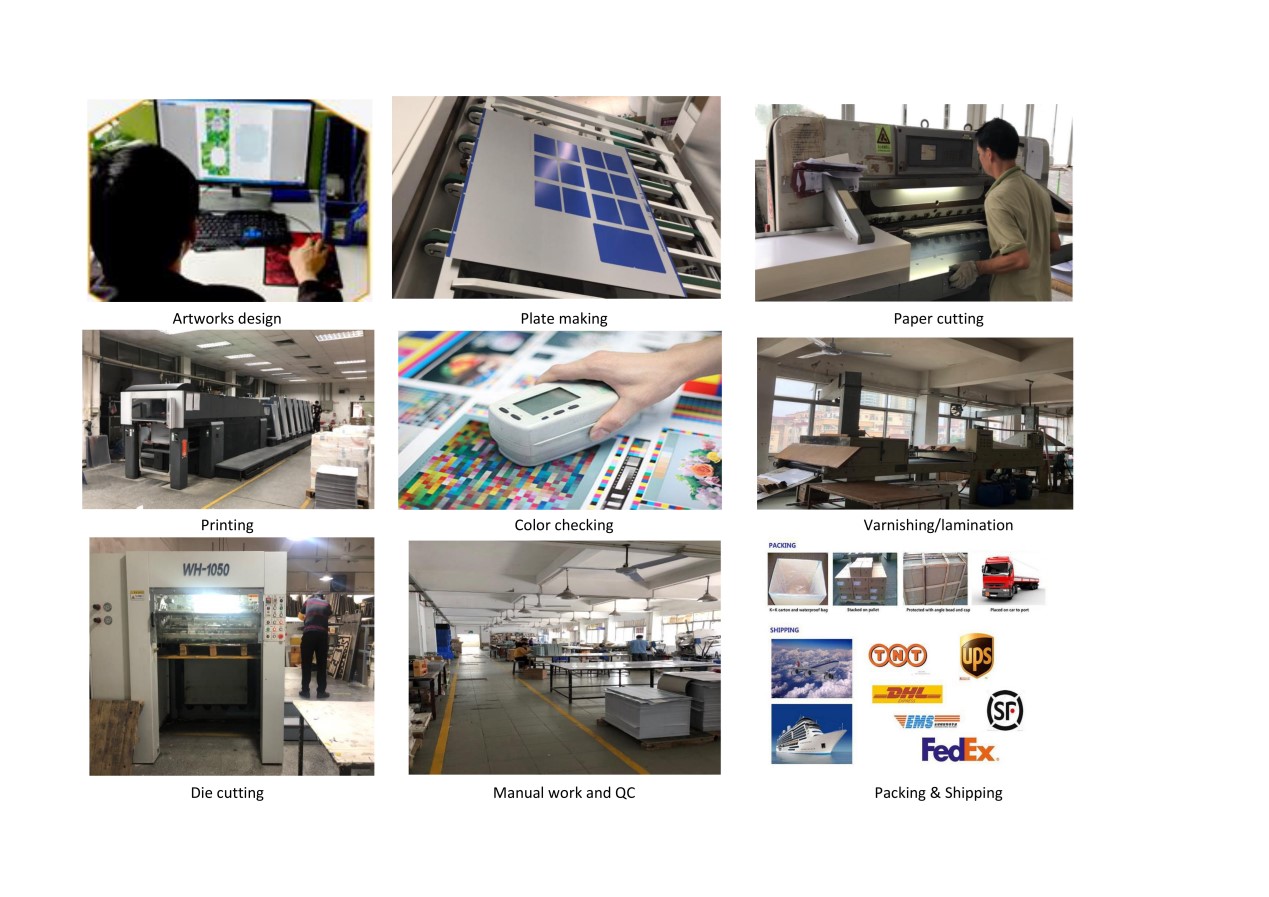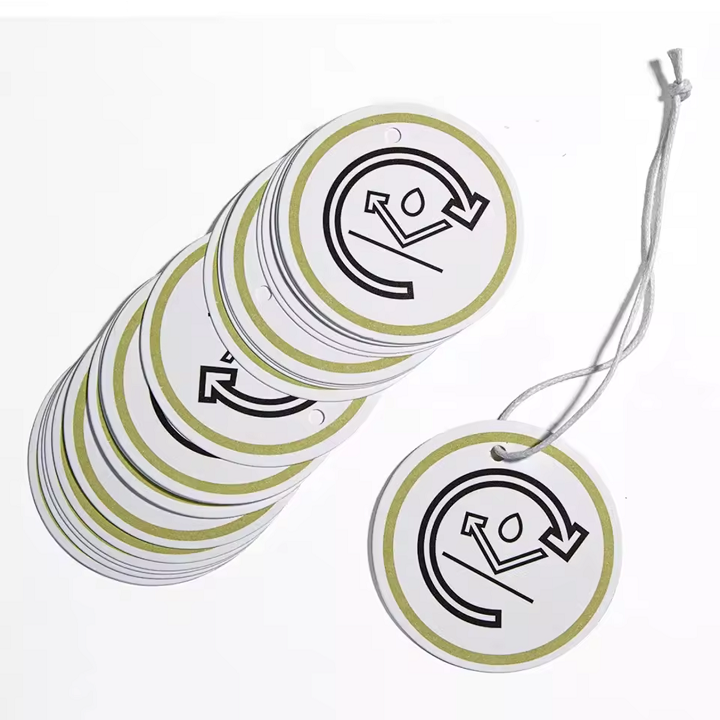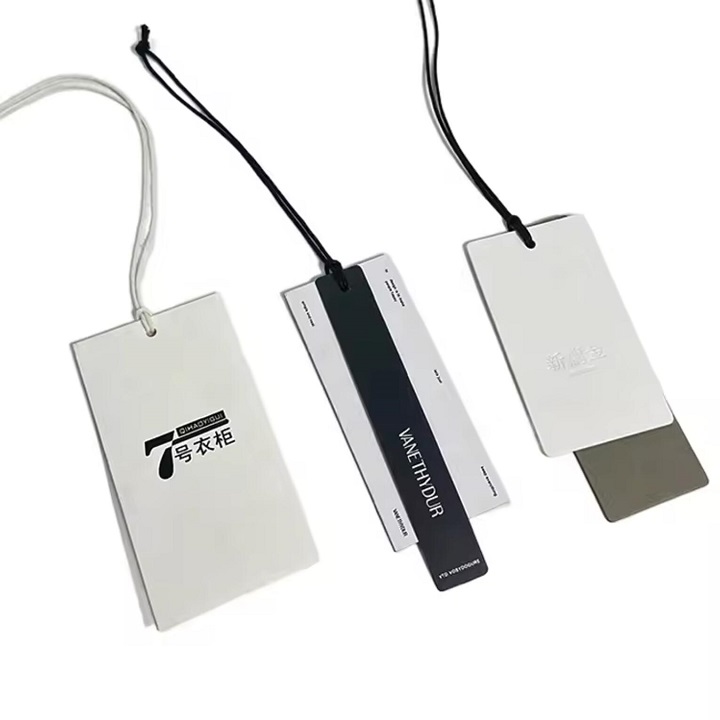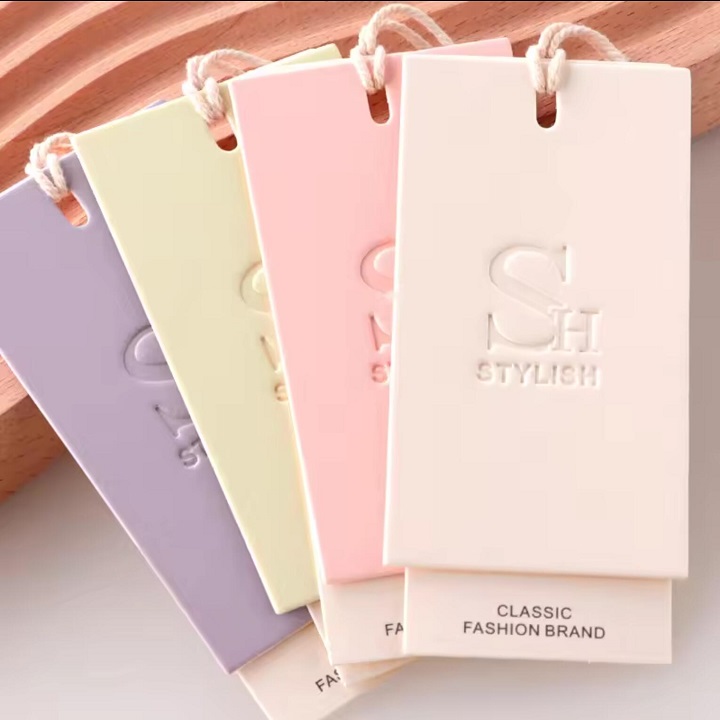Hang tags Categories
Hang tags are essential marketing tools used across various industries to provide information, branding, and pricing details about products. They are typically attached to items via strings or adhesive and serve as a direct communication channel with consumers. Here's a detailed classification of hang tags:
1.Based on Material
●Paper Hang Tags: The most common type, made from cardstock or paper, suitable for a wide range of products due to versatility and cost-effectiveness.
●Plastic Hang Tags: More durable than paper, often used for items that require waterproof or tear-resistant tags.
●Fabric Hang Tags: Made from fabric materials such as cotton, satin, or leather, offering a premium and tactile feel, commonly used for high-end fashion or textile products.
2.Based on Shape
●Rectangular Tags: Traditional shape, widely used for various products due to simplicity and ease of printing information.
●Die-cut Tags: Custom shapes that enhance product visibility and brand identity, often used for unique or specialty items.
●Round Tags: Circular tags that provide a distinctive look and are suitable for items where a softer, more organic shape is preferred.
3.Based on Functionality
●Informational Tags: Provide product details such as size, material, care instructions, and manufacturer information.
●Brand Tags: Focus on showcasing brand logos, slogans, and colors to reinforce brand identity and recognition.
●Promotional Tags: Include discounts, promotions, or special offers to encourage purchases, often used during sales or marketing campaigns.
4.Based on Attachment Method
●String Tags: Attached to products with strings or cords, offering flexibility in placement and ease of removal.
●Adhesive Tags: Stick directly onto products without strings, providing a clean and seamless appearance, commonly used for retail packaging or labeling.
5.Based on Industry
●Apparel Tags: Specifically designed for clothing items, often including size, fabric composition, washing instructions, and brand information.
●Jewelry Tags: Small tags tailored for jewelry items, typically showcasing price, material, and care instructions.
●Electronics Tags: Include technical specifications, warranty information, and safety instructions for electronic devices.
6.Based on Design Style
●Minimalist Tags: Clean and simple designs that focus on essential information without visual clutter.
●Graphic Tags: Incorporate images, patterns, or illustrations to enhance visual appeal and convey brand aesthetics.
●Textured Tags: Utilize embossing, foil stamping, or specialty finishes to create a tactile and luxurious feel, enhancing perceived product value.
7.Based on Sustainability
●Recyclable Tags: Made from recyclable materials such as paper or cardboard, supporting eco-friendly initiatives.
●Biodegradable Tags: Decompose naturally over time, reducing environmental impact compared to traditional plastic tags.
●Reusable Tags: Designed for multiple uses or repurposing, promoting sustainability and reducing waste in product packaging.
FAQs About Hang tags
1.What are hang tags used for?
Hang tags are used as labels attached to products to provide information such as brand name, price, care instructions, size, and other relevant details. They serve as a form of communication between the product and the consumer.
2.What materials are hang tags typically made from?
Hang tags are commonly made from materials such as cardboard, paper, plastic, or fabric. The choice of material depends on factors like durability, design aesthetics, and the type of product they will be attached to.
3.Can I customize the design of my hang tags?
Yes, hang tags can be fully customized to reflect your brand identity. You can choose the shape, size, color, typography, and graphics to create a unique look that aligns with your brand's image and message.
4.How are hang tags attached to products?
Hang tags are typically attached to products using strings, cords, ribbons, or plastic fasteners. The attachment method can vary depending on the type of product and the design of the hang tag.
5.Are hang tags environmentally friendly?
Hang tags can be made from sustainable materials such as recycled paper or biodegradable plastics to minimize environmental impact. Choosing eco-friendly materials and printing techniques is important for brands committed to sustainability.
6.What information should I include on a hang tag?
Essential information to include on a hang tag includes product name, brand logo, material composition, care instructions (like washing or handling), size, price, and any certifications or safety information relevant to the product.
7.Can hang tags be used for marketing purposes?
Yes, hang tags are versatile and can be used not only for product information but also for marketing purposes. They can feature promotional messages, QR codes linking to websites or social media, or even customer loyalty incentives.
8.How do I design an effective hang tag?
To design an effective hang tag, consider your target audience, brand identity, and the product's unique selling points. Use clear and concise language, attractive visuals, and ensure that all necessary information is easily readable and accessible.
9.Do you offer templates or design services for hang tags?
Yes, we companies offer templates or professional design services to help you create customized hang tags. These services can assist with layout, typography, graphics, and ensuring compliance with branding guidelines.
10.Can hang tags be used across different product categories?
Yes, hang tags are versatile and can be used across various product categories such as apparel, accessories, home goods, gifts, and more. They help to enhance the presentation of products and provide valuable information to consumers.
The Production Processes for Custom Hang Tags
1. Design and Conceptualization:
The process commences with meticulously designing the custom hang tag, taking into account pivotal factors such as brand identity, purpose, and the targeted audience. Designers harness software tools like Adobe Illustrator or InDesign to craft the layout, seamlessly integrating logos, text, and all essential product information tailored to the custom hang tag.
2. Material Selection:
Selecting the appropriate material for your custom hang tag is crucial, as it is based on the tag's intended purpose and the brand's image. Common materials encompass:
Paper (recycled or virgin), ideal for environmentally conscious or cost-effective options
Cardstock offers a sturdy yet elegant feel
Plastic, suitable for water-resistant or durable needs
Fabric, often chosen for a softer touch and unique texture
Wood, particularly favored by luxury or eco-friendly brands for an exquisite and sustainable statement
The chosen material significantly impacts the durability, print quality, and overall tactile experience of the custom hang tag.
3. Printing:
To ensure optimal results, the printing method is carefully selected based on the design intricacies and production quantity. The options include:
a. Digital Printing: Ideal for smaller production runs or custom hang tags requiring a myriad of color variations.
b. Offset Printing: Preferred for larger quantities, ensuring consistent color reproduction across all custom hang tags.
c. Screen Printing: Frequently utilized for fabric-based custom hang tags or to achieve special visual effects.
Moreover, some manufacturers opt for eco-friendly inks, aligning with sustainability goals and enhancing the eco-conscious appeal of the custom hang tags.
4. Special Finishes (Optional):
Enhance the appearance and durability of your Custom Hang Tags with special finishes:
Embossing or debossing for added texture and depth to your Custom Hang Tags
Foil stamping to incorporate metallic accents, making your Custom Hang Tags stand out
Spot UV coating for glossy highlights that catch the eye on your Custom Hang Tags
Lamination for protection and a sleek sheen, ensuring your Custom Hang Tags retain their quality
5. Die-Cutting:
Craft unique Custom Hang Tags by utilizing a die-cutting process to achieve custom shapes.
This precision step not only gives your Custom Hang Tags their final shape but also creates any necessary holes for strings or attachments, ensuring they are tailored to your specific needs.
6. Hole Punching:
For Custom Hang Tags intended to be attached with string or other fasteners, a precisely punched hole is essential.
The strategic location and size of this hole are crucial for ensuring proper hanging and optimal visibility of your Custom Hang Tags.
7. String or Fastener Attachment:
Complement the design and purpose of your Custom Hang Tags by selecting the most appropriate attachments, including:
Cotton or polyester strings for a soft and natural look
Plastic fasteners for durability and versatility
Metal pins for a sleek and modern aesthetic
Elastic cords for added flexibility and adaptability
The attachment method chosen should seamlessly integrate with the overall design of your Custom Hang Tags, enhancing their functionality and appeal.
8. Quality Control:
Rigorously inspect each Custom Hang Tag for printing quality, ensuring that the colors are vibrant, the text is clear, and the images are sharp. Verify that all Custom Hang Tags contain the correct information and have undergone the proper finishing processes to meet the highest standards. Ensure that every Custom Hang Tags adheres to the required specifications and embodies the essence of your brand.
9. Packaging and Distribution:
Package the meticulously crafted Custom Hang Tags with care, utilizing protective materials to safeguard against damage during shipping. Organize the packaged Custom Hang Tags by product line or category, facilitating swift and efficient distribution to your retail outlets or directly to your customers. This ensures that your Custom Hang Tags arrive in pristine condition, ready to enhance the presentation and appeal of your products.

What Custom Hand Tags Are Used For?
1. Product Information:
Custom Hang tags provide essential details about a product, such as size, material composition, and care instructions.
They often include barcodes or QR codes for easy scanning and inventory management.
2. Branding and Marketing:
Custom Hang tags serve as a mini-billboard for brand logos and slogans.
They can reinforce brand identity through color schemes and design elements.
3. Pricing:
Many retailers use custom hang tags to display product prices clearly.
Tags can easily be updated for sales or price changes.
4. Authenticity Verification:
Luxury brands often use specialized hang tags to help customers verify product authenticity.
These may include holograms or unique serial numbers.
5. Promotional Information:
Custom hang tags can advertise special offers, discounts, or upcoming promotions.
6. Product Origin and Sustainability:
Tags often indicate the country of origin and may highlight eco-friendly or fair trade practices.
7. Gift Messaging:
Some retailers offer custom hang tags for gift purchases, allowing personal messages.
8. Assembly or Usage Instructions:
For products requiring assembly or special care, custom hang tags may include brief instructions or direct users to more detailed resources.
9. Warranty Information:
Custom hang tags sometimes contain warranty details or registration instructions.
10. Size Indicators:
In clothing retail, custom hang tags often prominently display size information for easy browsing.
11. Material and Fabric Information:
Especially important in textiles, custom hang tags detail fabric composition and care requirements.
12. Tracking and Inventory Management:
RFID-enabled hang tags help retailers track inventory and prevent theft.
13. Product Features and Benefits:
Custom hang tags often highlight key features or unique selling points of a product.
14. Legal Compliance:
Certain industries require specific information on custom hang tags to comply with regulations.
15. Cross-selling and Upselling:
Tags may suggest complementary products or upgrades.
 |  |  |
Circle Hang Tags
| Rectangular Hang Tags
| Clothing Hang Tags
|
















